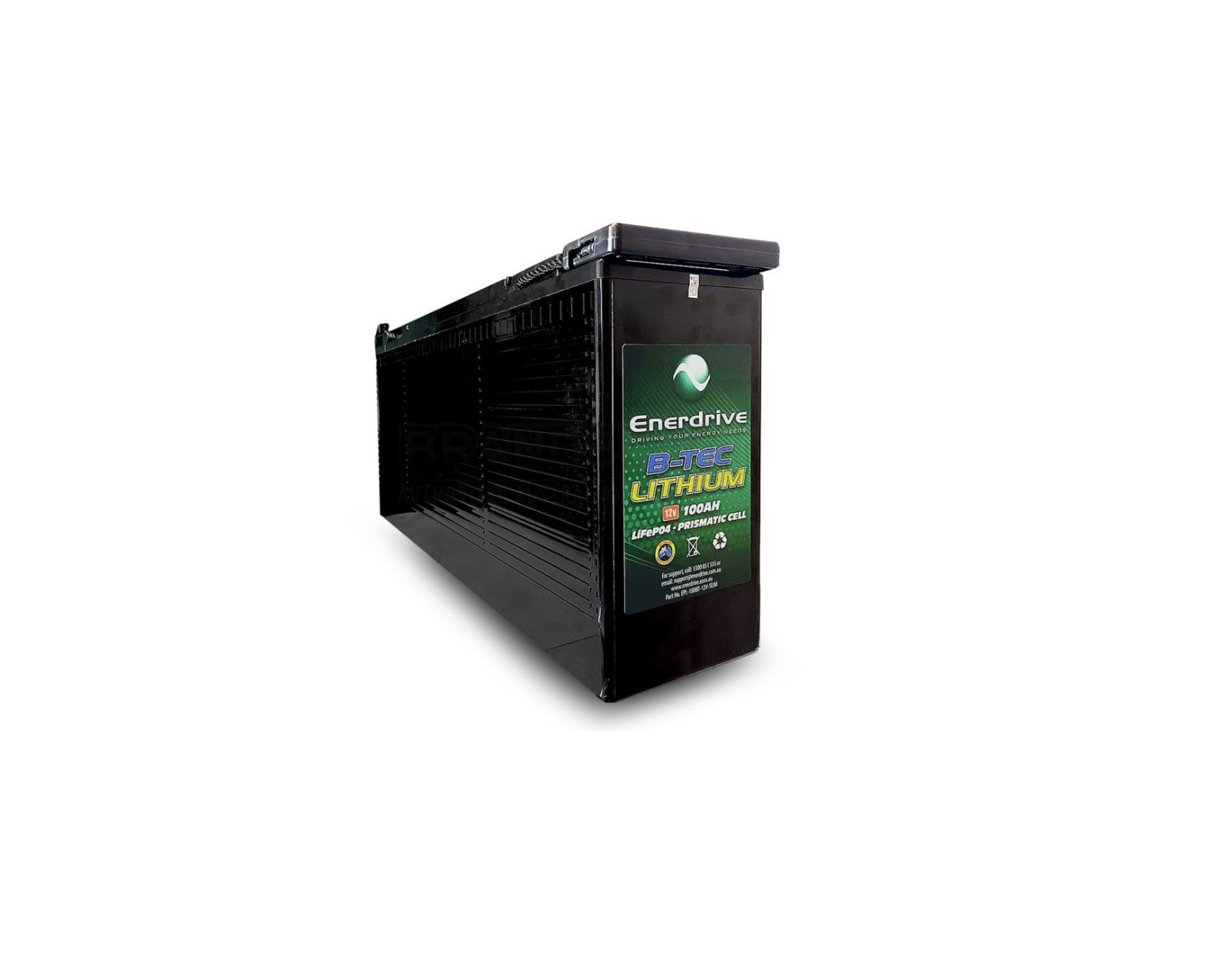Enerdrive EPL-100BT-12V-SLIM B-TEC 100Ah 12V LiFePO4 Slim Case Lithium Battery Owner's Manual
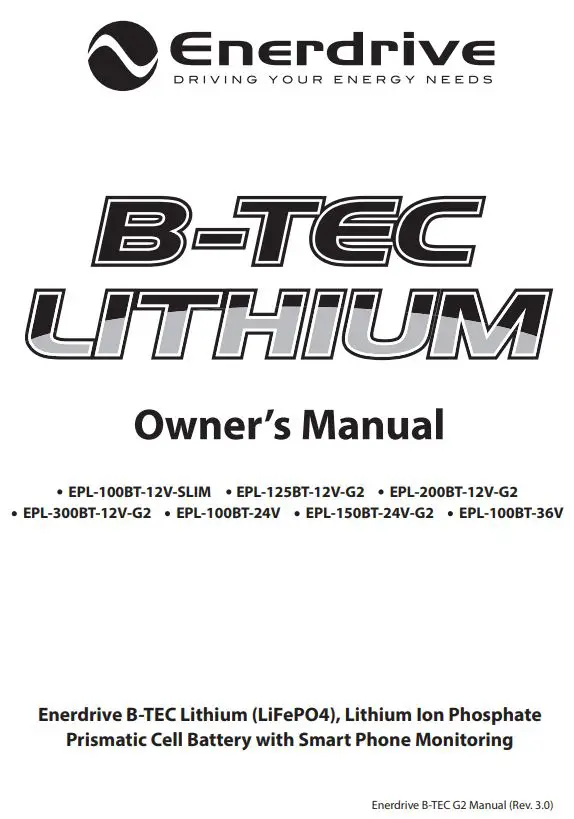
For safe and optimum performance, the Enerdrive ePOWER B-TEC LiFePO4 Lithium Ion Phosphate Battery with Smart Phone Monitoring must be used properly. Carefully read and follow all instructions and guidelines in this manual and give special attention to the CAUTION and WARNING statements.
PLEASE KEEP THIS MANUAL FOR FUTURE REFERENCE
Disclaimer
Please be sure to read and save the entire manual before using your Enerdrive ePOWER B-TEC LiFePO4 Lithium Ion Phosphate Battery with Smart Phone Monitoring. Misuse may result in damage to the battery, and/or cause harm or serious injury. Read manual in its entirety before using the unit and save manual for future reference.
Product NumberEPL-100BT-12V-SLIMEPL-125BT-12V-G2EPL-200BT-12V-G2EPL-300BT-12V-G2EPL-100BT-24VEPL-150BT-24V-G2EPL-100BT-36V
Document Part Number
Enerdrive B-TEC G2 Manual (Rev. 3.0) 2021
Support Contact InformationDomestic Power & Control (Enerdrive) Pty LtdWarranty Returns: Reply Paid 8786, Wynnum Plaza, QLD 4178Email: [email protected]www.enerdrive.com.au
Section 1 – Installation
Your B-TEC battery must be installed in a dry and cool location.
Supplied battery trays and straps are the preferred mounting method. Ensure that sufficiently rated fasteners are used to hold the tray firmly to the mounting material.
Enerdrive approve installation of B-TEC batteries in accommodation areas of RV’s. Temperatures must not exceed the rated operating temperatures therefore natural, or fan forced ventilation maybe required.
There should be 25mm clear space around the B-TEC battery.
Consideration should be taken to not mount the battery near any metallic service lines such as LPG, diesel, or petrol lines. This is to ensure no accidental shorting of the battery terminals occur, especially when fitting or removing the battery.
B-TEC batteries must not be installed –
- In vehicle engine bays or in high heat environments, refer to Section 10 – Battery Specifications
- In wet areas such as caravan chassis mounts, open Ute trays or boat deck areas.
- Inside compartments dedicated to carrying gas.
Refer to applicable transportable structures or marine standards for further installation requirements.
Section 2 – Connection
It is recommended that no more than four terminals be connected to a battery terminal, if you do have more than 4 terminals the use of a fuse block and negative busbar are recommended. Cable terminal should be order with heaviest current draw in contact with the battery to light current draw terminals on the top.
Use of insulating terminal boots is recommended, especially in areas where accidental shorting may occur, such as storage lockers or under lounges and beds. Connect the Positive (Red) and Negative (Black) cables to the battery, ensuring you are using cable that is of adequate size for the demands of the system, and well crimped and protected termination lugs.
Example;1000W Inverter – at least Gauge 2 (35mm²)2000W Inverter – at least Gauge 00 (70mm²)
Cable Conversion Guide

The spring washers must be used on the battery terminal bolts – they apply pressure to the lugs for a secure connection. There is no need to over-tighten the bolts, simply ensure there is no movement of the cables. Make sure the main Battery Cable lug is mounted directly onto the Battery terminal with no washers between them.
Section 3 – Charging
Lithium batteries need to be charged slightly different to other batteries.
To ensure they live a long life and provide maximum capacity, you must use a charger with a lithium LiFeP04 setting – this includes:
- AC Chargers
- DC to DC Chargers
- Solar Controllers
If your charger allows, set the charge voltage from 14.2 – 14.6 Volts and Float 13.5 – 13.6 Volts and proceed with charging. We recommend charging at the lower end of the voltage scale for maximum longevity of the battery.
It is recommended that the charging current should be 30% of your battery capacity. You can charge at higher currents but 30% is the recommended for long life. See Section 10 – Battery Specifications.
*Note:You can charge a lithium battery with a non-lithium charger, but these chargers can deliver too much or too little voltage and may not cut off when the battery is full.
DO NOT use a charger with a “Pulse Stage” or “Equalisation Mode”. This will damage the battery and void warranty.
DO NOT connect this battery to a start battery with a VSR (Dual Battery System or “Voltage Sensitive Relay”). The voltage of the Lithium battery may keep the VSR switched on resulting in it discharging into the start battery.
Section 4 – Discharging (using the battery)
The Enerdrive B-TEC Lithium Battery can deliver a very high discharge current due to the high power, high quality Battery Management System (BMS) and prismatic Lithium cells inside the battery. Refer to Section 10 – Battery Specifications for the maximum rated discharge current of your battery.For this to happen, you MUST USE cable of the correct gauge.
Consider current like plumbing… The thicker the pipe (cable) the more current can flow through it.
These are recommended wire guages and approximate current specifications for cable lengths shorter than 1 – 2 metres:
Guage 235mm²155Amps
Guage 050mm²185Amps
Guage 0070mm²240Amps
A 2000W inverter will draw approximately 170-180 Amps through the cables connected between it and the battery – this will NOT be achieved with undersized wire.
Inverter Usage
It is recommended to not put more load on your batteries than the rating of the BMS installed. We also recommend following the below even if you have two batteries in parallel, this protects overloading a single battery if the other battery in the bank was to shut down (i.e. low capacity).
- 12V 100AH B-TEC – 12V 1000W Inverter Max
- 12V 125AH B-TEC – 12V 1000W Inverter Max
- 12V 200AH B-TEC – 12V 2600W Inverter Max
- 12V 300AH B-TEC – 12V 3500W Inverter Max
- 24V 150AH B-TEC – 24V 3500W Inverter Max
Section 5 – Protecting Your Battery
Lithium batteries cannot be protected effectively by monitoring voltage due to their ability to maintain a higher voltage for much longer than AGM or flooded/sealed batteries.
“State of Charge” (SOC%) percentage is the most accurate and effective method of disconnecting loads from the battery – this requires a battery monitor which uses a “shunt” to measure the current going into (Charging) and coming out of (Discharging) the battery.
Example; 200 Amp Battery
Fully Charged50 Amps used100 Amps used
State of Charge = 100%State of Charge = 75%State of Charge = 50%
It is recommended that Lithium batteries not be discharged below 20% State of Charge or the battery life may be shortened.
As an added layer of protection, the Enerdrive B-TEC Lithium Battery also has a built-in low voltage disconnect circuit. If this occurs, please refer to Section 6 – Restarting Your Battery.
If your battery has shut down due to low voltage you must charge your battery within 14 days to prevent permanent damage occurring to the cells.
Section 6 – Restarting Your Battery
Batteries with Reset Button on BatteryWe strongly recommend keeping the battery charged to avoid activating the internal low battery voltage disconnect.If your DC system shuts down, the battery may require re-starting. Please use the following procedure:
- Turn off all DC and AC Loads
- Connect charging source/s and switch ON
- Hold the “Reset” button on top of the battery for 5-10 seconds
- Release and wait 7 seconds
- Power should now be restored and charging will commence
- When the SOC (State of Charge) is above 20%, loads can be switched on if required
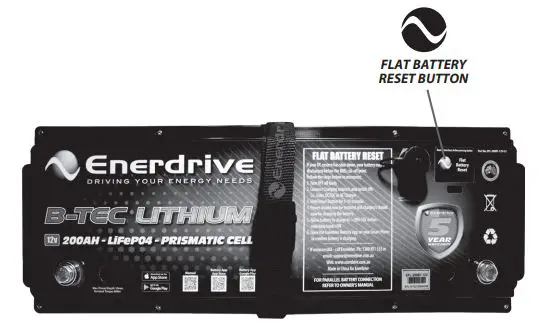
By continuously tripping the low voltage disconnect of the battery you may cause damage to sensitive electronic equipment that is attached to the battery. i.e. battery chargers, solar controllers, inverters, stereo equipment etc – all of which are not covered under the battery warranty.
Batteries without Reset Button on BatteryTo reconnect, a charge voltage of 12.8v must be applied to the battery before the over-discharge release will activate and allow charge current to flow into the battery. This can be done via a momentary reset switch between the start battery and B-TEC or by jump starting with a portable power pack. Follow the above steps to turn off all DC and AC loads, turn on charging sources and then activate reset switch or apply jump start pack, disconnect as soon as chargers begging charging.
Section 7 – Using the Smart Phone Battery Monitor App
The Enerdrive B-TEC Lithium Battery incorporates a wireless Smart Phone Monitoring system. By downloading the Android™ or Apple® app to your Smart Phone or tablet device, you can monitor the following information;
- Battery Capacity
- Battery Voltage
- Battery Current (Amps)
- Battery State of Charge (SOC)
- Battery State of Health (SOH)
- Battery Status
- Individual Cell Voltage
- Battery Temperature
- Battery Cycles
- Battery Alarms
- Battery Event Information
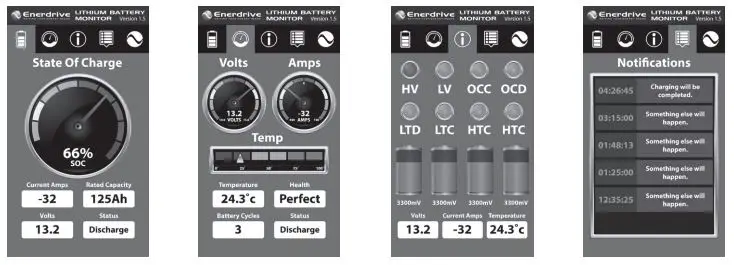
Alarms DefinitionsHV – High VoltageLV – Low VoltageOCC – Over Current ChargeOCD – Over Current DischargeLTD – Low Temperature DischargeLTC – Low Temperature ChargeHTD – High Temperature DischargeHTC – High Temperature Charge(Refer to Section 10 – Battery Specifications for values).
* Red light is only an indicator, not a fault condition.* The default password is 1234 (this allows you to change the Bluetooth name of the battery).* A notification will only appear in the notifications page if under alarm condition.
Section 8 – Warnings
Please read and follow the cautions listed on the battery before installation. Improper use may cause heat, fire, rupture, damage or capacity deterioration of the battery. Enerdrive Pty Ltd is not responsible for any accidents cause by the usage without following our specification.
![]()
Low Battery Voltage Disconnect
The battery has a low voltage disconnect incorporated for self-protection. If the battery is drawn down to the internal low voltage disconnect set point (2.8v per cell) the battery will disconnect.
Section 9 – FAQ
Q: Can I parallel B-TEC batteries?A: The short answer is yes.The long answer is – if you are drawing large currents, the maximum current delivered will be limited to the maximum instantaneous discharge capacity of one battery (200 Amps).
With low to medium current draw installations (the vast majority of applications) you may never see an issue and your storage capacity will be greatly increased – I.E. 2 x 200 Amp = 400 Amp capacity.
When installing, ensure they are fully charged, separately – then let sit for 30 minutes before connecting together. When connecting in parallel – take the positive from Battery 1, and the negative from Battery 2 to your system as per the diagram below.
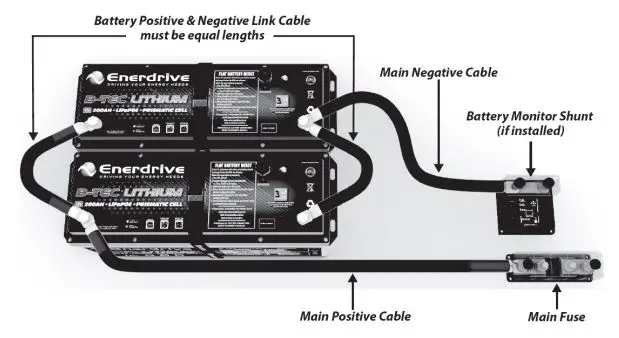
The Smart Phone App will only show the information from one battery at a time – not both. This is another advantage of a separate Battery Monitor – it will show the total system environment.
*Note: Slight variance of State of Charge or Amps may occur between the batteries in parallel however these should not vary by more than 5%. It is recommend that annually the batteries be disconnected and individually charged allowing them to sit at state for 12hrs each before connecting together.
Q: Can I series connect B-TEC batteries to achieve higher voltage?A: No. Enerdrive offers higher voltage Lithium solutions – contact us for details.
Q: Can I use an Inverter with my B-TEC battery?A: Yes. Refer to Section 4 for more detail.
Q: Can I install the B-TEC battery in a wet area?A: No. Due to the construction of the B-TEC cases the batteries must be installed in a dry environment toprotect against moisture ingress.
Q: Can I install the B-TEC battery on its side or end?A: No.
Section 10 – Specifications
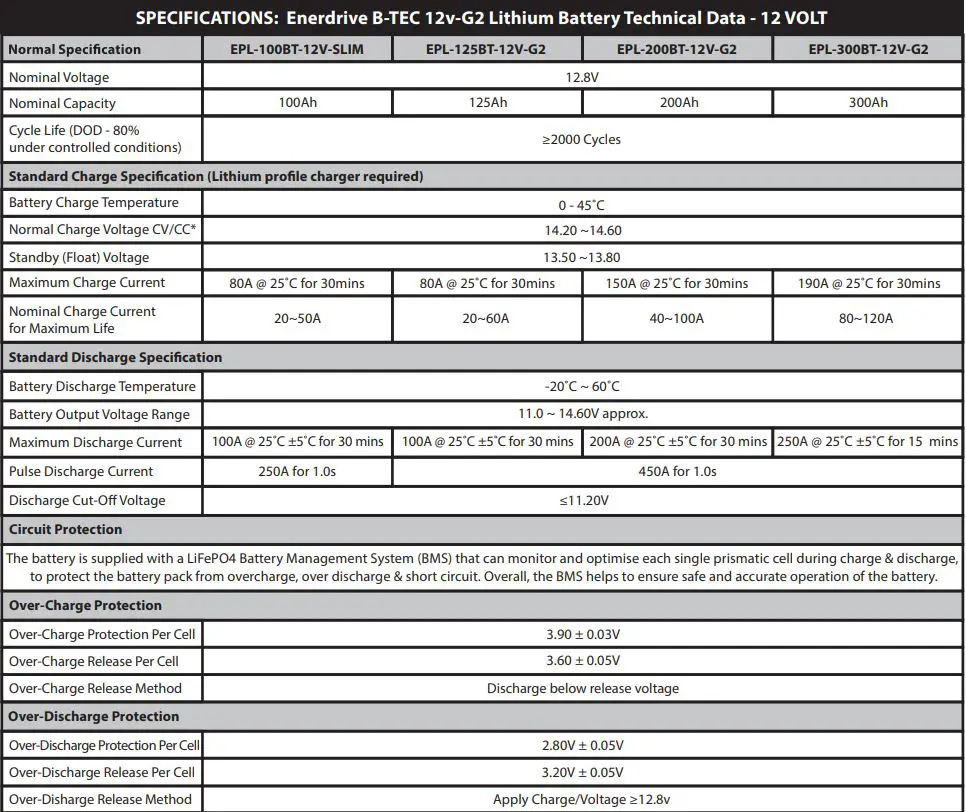

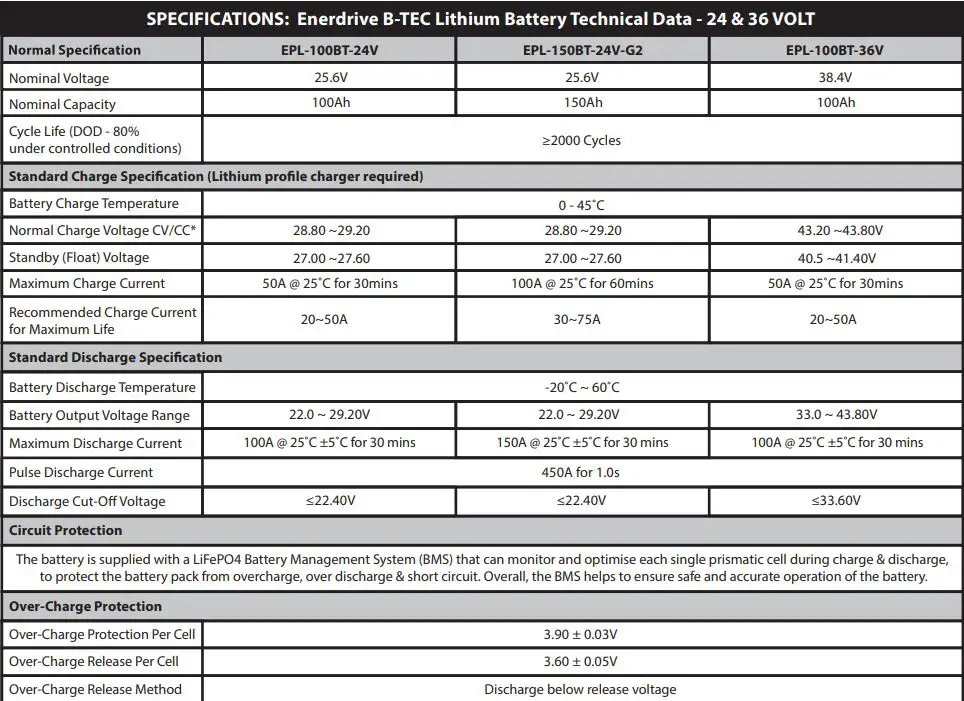
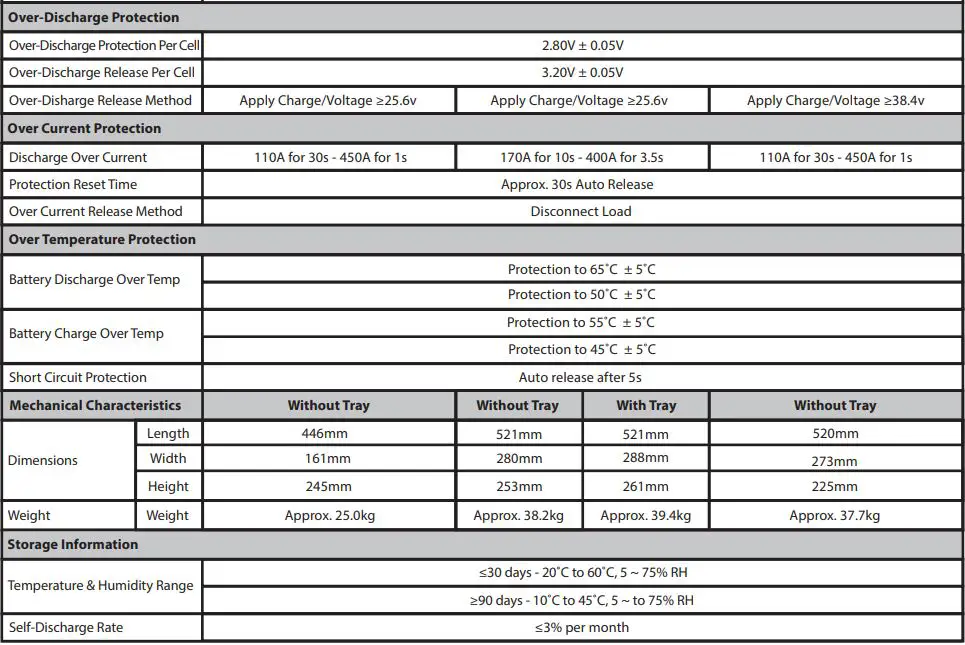
Section 11 – DIMENSIONS
EPL-100BT-12V-SLIMDIMENSIONS (NO STRAP & TRAY INCLUDED WITH THIS MODEL)
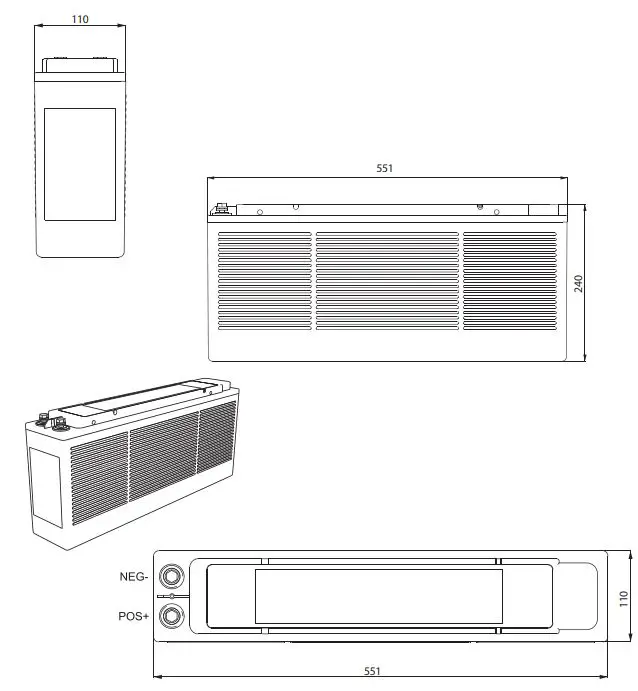
EPL-125BT-12V-G2DIMENSIONS WITHOUT STRAP & TRAY
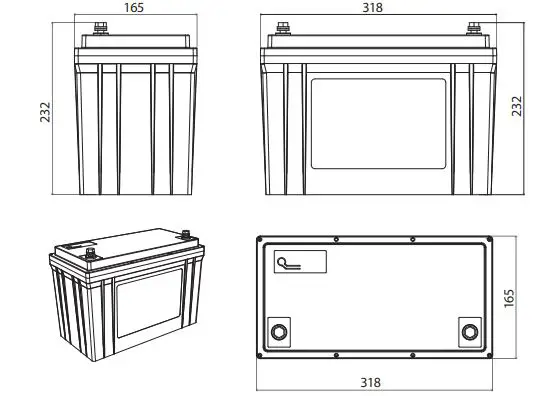
EPL-125BT-12V-G2DIMENSIONS WITH STRAP & TRAY
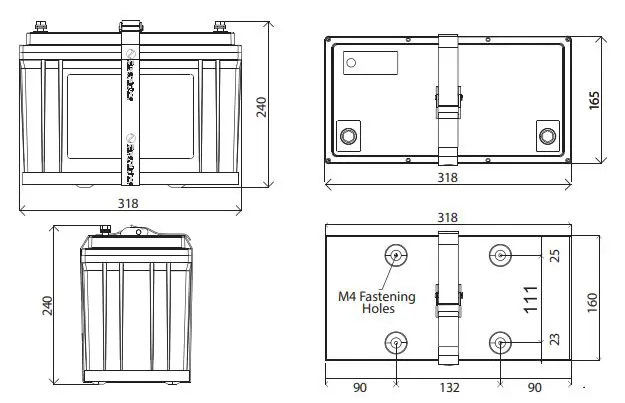
EPL-200BT-12V-G2DIMENSIONS WITHOUT STRAP & TRAY
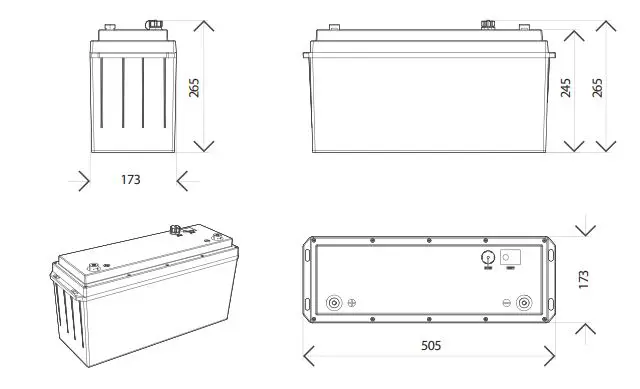
EPL-200BT-12V-G2DIMENSIONS WITH STRAP & TRAY
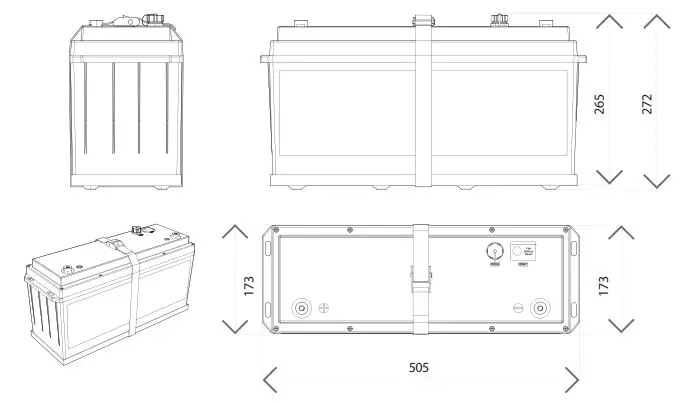
EPL-300BT-12V-G2DIMENSIONS WITHOUT STRAP & TRAY
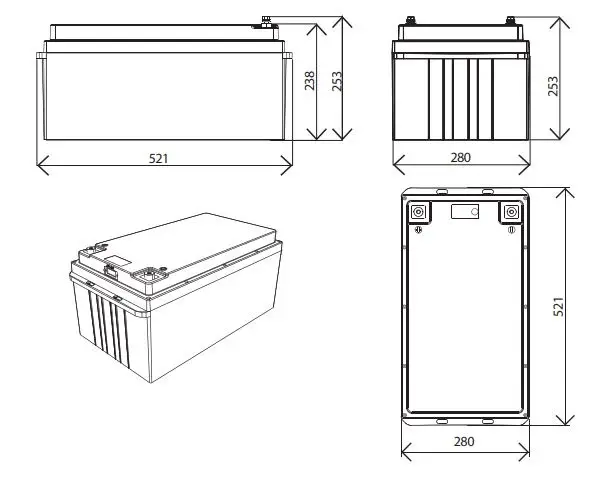
EPL-300BT-12V-G2DIMENSIONS WITH STRAP & TRAY
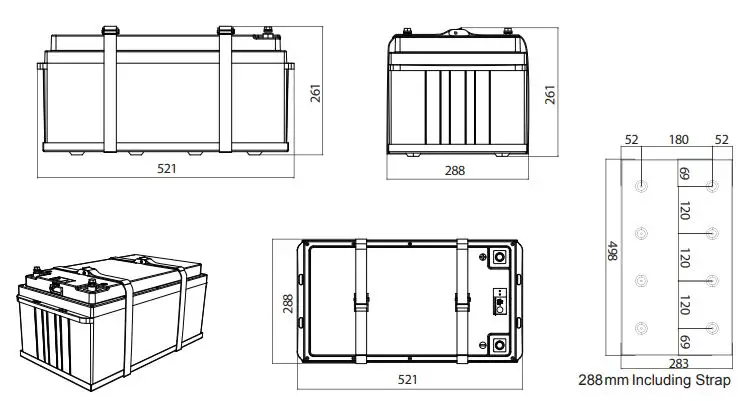
EPL-100BT-24V
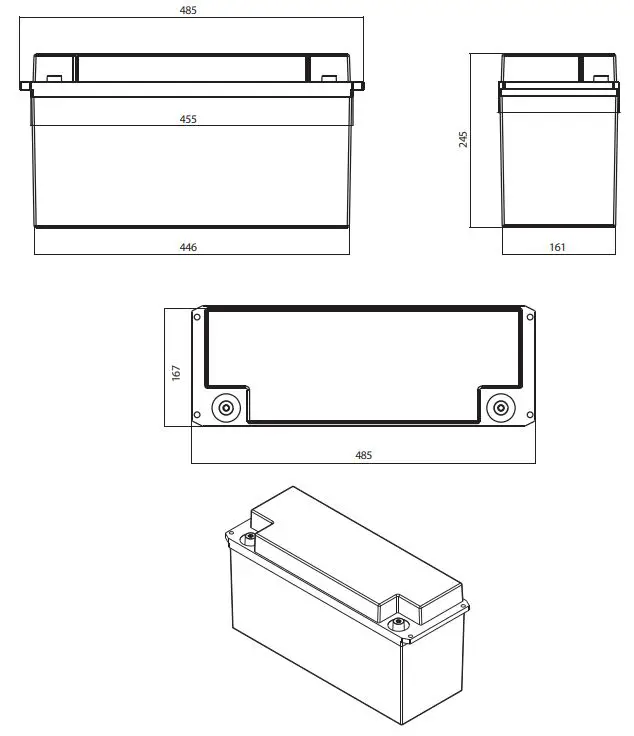
EPL-150BT-24V-G2DIMENSIONS WITHOUT STRAP & TRAY
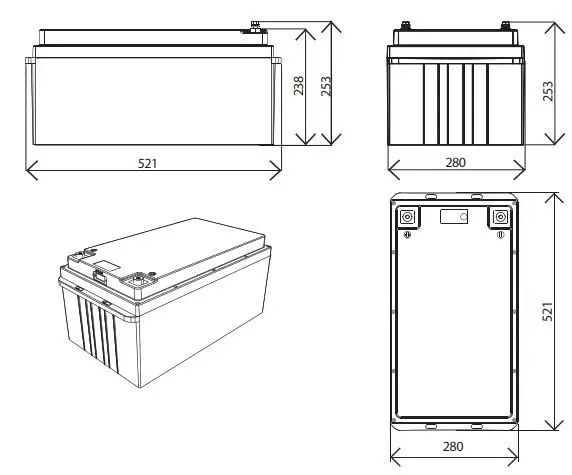
EPL-150BT-24V-G2DIMENSIONS WITH STRAP & TRAY
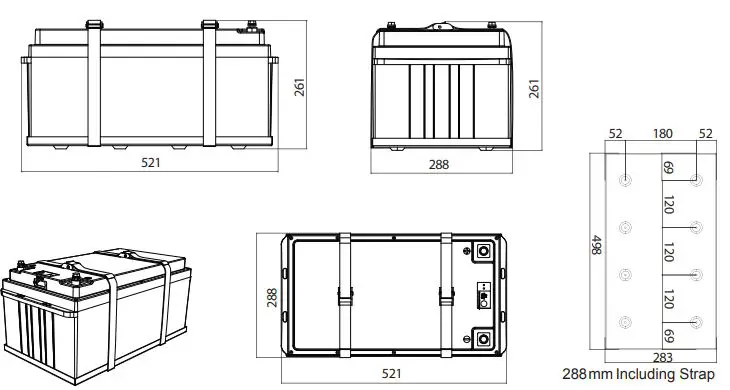
EPL-100BT-36V
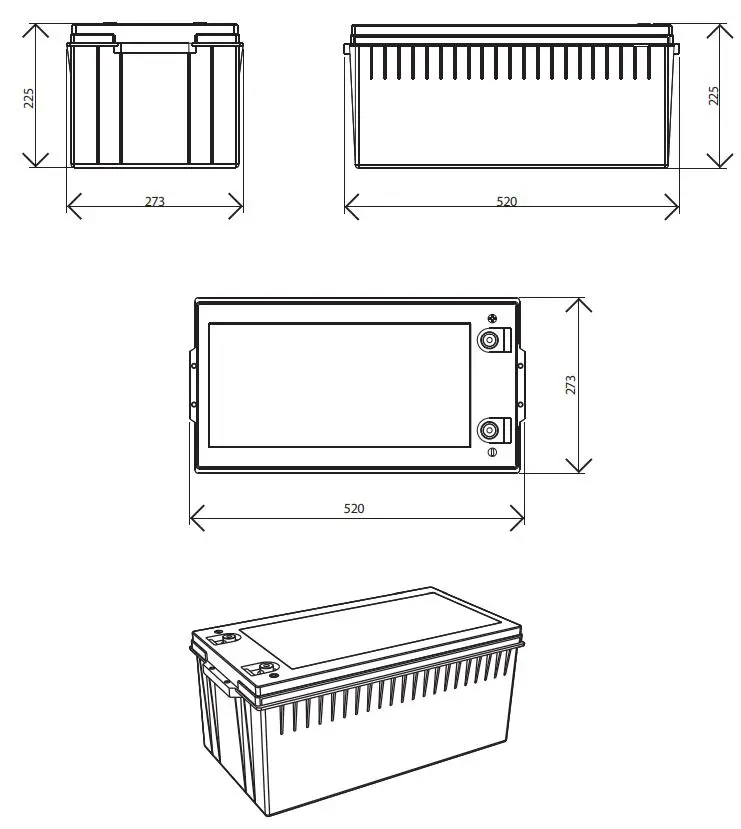
Section 12 – Warranty
 5 Year WarrantyIn the unlikely event that a technical issue arises with an Enerdrive product, customers are encouraged to initially contact the Enerdrive Support Team on 1300 851 535 or [email protected] for immediate and efficient expertise and first class product support.
5 Year WarrantyIn the unlikely event that a technical issue arises with an Enerdrive product, customers are encouraged to initially contact the Enerdrive Support Team on 1300 851 535 or [email protected] for immediate and efficient expertise and first class product support.
Important Note: Consumer ProtectionsIf you have purchased your product in Australia, you should be aware that:
This warranty is provided in addition to other rights and remedies held by a consumer at law. Our goods come with guarantees that cannot be excluded under the Australian Consumer Law. You are entitled to a replacement or refund for a major failure and for compensation for any other reasonably foreseeable loss or damage. You are also entitled to have the goods repaired or replaced if the goods fail to be of acceptable quality and the failure does not amount to a major failure.
Enerdrive warrants that its Products will be free from defects in materials and workmanship (subject to limits, and in normal conditions, as described in the complete Enerdrive Warranty Policy) for up to 5 years from the date of purchase.
For full terms, conditions and claim process, refer to the Enerdrive website. https://enerdrive.com.au/warranty/
NOTES:________________________________________________________________________________________________________________________________________________________________________________________________________________________________________________________________________________________________________________________________________

Domestic Power & Control (Enerdrive) Pty LtdP.O. Box 9159, Wynnum Plaza, Queensland, Australia 4178 Ph: 1300 851 535 / Fax: 07 3390 6911 Email: [email protected]Web: www.enerdrive.com.au
References
[xyz-ips snippet=”download-snippet”]

